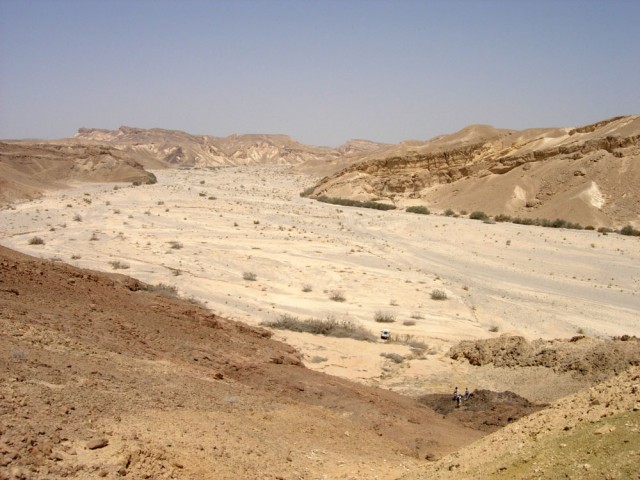wadi
A WADI IS A RAVINE or gully in the MIDDLE EAST or northern Africa that is dry for most of the year. The word wadi means “valley” or “ravine” in Arabic. When the rainy season comes, great quantities of water may rush through the wadis, destroying lives and property. Most of the year, wadis are either dry or have intermittent stream flow. They can range in size from small gullies to large, deep canyons. An inverted wadi is a formation with ridges that follow the floor of the former wadi. The tops of the ridge mark where the floor of the wadi once was. The material on both sides of it has been washed away, but because it was mostly gravel, the wadi floor remained and is now raised.
Wadis are usually found in DESERTs, which are generally considered to be areas that have less than 10 in (250 mm) of precipitation a year. Often the sides of the wadi are undercut by the swiftly moving water that has rushed through. The wadi floor is usually covered with silt and has rounded boulders that have been tumbled smooth by the motion of the water. A heavy rain often produces a flash flood in which rock debris and sediment from the wadi floor are carried along with the water. A huge amount of sediment can be moved in a short time during a flash flood. The water foams, because of trapped air bubbles. At the point where the wadi emerges from the hills onto the plain, the water slows down and the sediment it is carrying is deposited in the form of an ALLUVIAL FAN. Heavier materials are dropped first, and the finest material travels the farthest. The water may spread into a PLAYA lake.

Some wadis contain sparse vegetation along their channels. Acacia trees grow along narrow rock wadis in the NEGEV DESERT in southern ISRAEL. In the Libyan Desert, the only vegetation outside oases is found in the wadis. Types of vegetation there include grasses, shrubs, and several varieties of acacia trees. Seeds can be distributed by floodwaters. Wadis serve as breeding places for certain wildlife. The desert locust breeds in wadis in northern Africa, Arabia, and Southwest Asia. Shallow, bushy wadis in the Negev Desert are a prime breeding place for the spectacled warbler. The red fox lives near wadis in Arabia.
Wadi Rum, in the Middle East country of JORDAN, was formed differently from most wadis. Geologists believe that an enormous upheaval in the Earth's crust shattered huge pieces of rock and resulted in a deep crack in the Earth's surface that became Wadi Rum. Scientists believe the area has been inhabited since the 8h century B.C.E. The Central Plateau of SAUDI ARABIA, called the Nejd, is deeply cut by wadis that were formed by temporary streams that carried water only after a rain.
In October 2003, torrential rains in the western SAHARA DESERT in MOROCCO caused the creation of new wadis and widespread flooding. In many desert areas, manmade terraced wadis are being built to divert flash flood waters to adjacent fields. Also runoff waters are collected in natural depressions for use later.